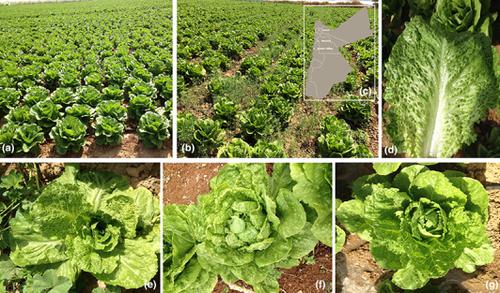当前位置:
X-MOL 学术
›
Ann. Appl. Biol.
›
论文详情
Our official English website, www.x-mol.net, welcomes your feedback! (Note: you will need to create a separate account there.)
Occurrence and partial genetic characterisation of Lettuce big‐vein associated virus and Mirafiori lettuce big‐vein virus infecting lettuce in Jordan
Annals of Applied Biology ( IF 2.6 ) Pub Date : 2020-05-11 , DOI: 10.1111/aab.12595 Nida' Salem 1 , Saja Odeh 1 , Motasem Abu Muslem 1 , Rachid Tahzima 2, 3
Annals of Applied Biology ( IF 2.6 ) Pub Date : 2020-05-11 , DOI: 10.1111/aab.12595 Nida' Salem 1 , Saja Odeh 1 , Motasem Abu Muslem 1 , Rachid Tahzima 2, 3
Affiliation

|
Lettuce big‐vein disease (LBVD) is an economically damaging disease that occurs in most lettuce production areas worldwide. Several studies have associated LBVD with a complex of two viruses, Lettuce big‐vein associated virus (LBVaV) and Mirafiori lettuce big‐vein virus (MiLBVV). Both viruses are transmitted through soil by the zoospores of the chytridiomycete fungus Olpidium virulentus. During surveys carried out in two growing seasons from 2015 to 2016 in the main vegetable growing areas in Jordan (Jordan Valley, Jerash, and Madaba), 179 lettuce plants, 46 lettuce seedlings, and 56 weed plants were collected. RNA extraction was conducted from leaves of all samples. Associated viruses were identified using reverse transcription‐polymerase chain reaction (RT‐PCR) with specific primer pairs targeting part of the coat protein (CP) genes of LBVaV and MiLBVV. RT‐PCR results revealed that, out of 225 lettuce samples tested, 32 (14%) and 44 (20%) were singly infected with LBVaV and MiLBVV, respectively, and 73 (32%) samples were dually infected with LBVaV and MiLBVV. Overall, MiLBVV was detected in more lettuce samples (117) compared with LBVaV which was detected in 105 samples. Moreover, one sample of each weed species of Chenopodium murale and Sonchus oleraceus tested positive for MiLBVV and LBVaV, respectively. The partial nucleotide sequence of the CP genes of LBVaV and MiLBVV Jordanian isolates showed similarities to other isolates available in the NCBI database ranging between 93.9–100% and 88.3–100%, respectively. Nucleotide sequence comparison of the Jordanian isolates and inference from phylogenetic trees with strong support revealed well‐defined sub‐groups with little or no correlation with planting area or geographic origin. The occurrence of both viruses in lettuce plants was associated with the presence of resting spores and zoospores of Olpidium spp. in lettuce plants grown under field and growth chamber conditions. Lettuce plants inoculated with Olpidium spp. zoospores isolated from roots of symptomatic lettuce plants, developed LBVD‐symptoms. At 60 days post‐transplantation, both viruses were detected by RT‐PCR in most of the plants analysed. Biological and molecular assays together with the light microscopy observations of resting spores and zoospores of Olpidium spp., revealed the presence of LBVaV, MiLBVV, and O. virulentus in big‐vein diseased lettuce plants.
中文翻译:

约旦生菜大静脉相关病毒和米拉菲奥里生菜大静脉病毒感染生菜的发生和部分遗传特征
生菜大静脉疾病(LBVD)是一种经济破坏性疾病,在全球大多数生菜产区均发生。多项研究已将LBVD与两种病毒(莴苣大静脉相关病毒(LBVaV)和Mirafiori生菜大静脉病毒(MiLBVV))的复合体相关联。两种病毒均由乳糜菌真菌游丝游动孢子的游动孢子通过土壤传播。在2015年至2016年的两个生长季节中,对约旦的主要蔬菜种植区(乔丹谷,杰拉什和马达巴)进行了调查,收集了179种莴苣植物,46种莴苣幼苗和56种杂草植物。从所有样品的叶子进行RNA提取。使用逆转录聚合酶链反应(RT-PCR)鉴定了相关病毒,其中特异性引物对靶向LBVaV和MiLBVV的外壳蛋白(CP)基因的一部分。RT‐PCR结果显示,在225个生菜样品中,分别有32个(14%)和44个(20%)被LBVaV和MiLBVV单独感染,而73个(32%)样品被LBVaV和MiLBVV双重感染。总体而言,与在105个样品中检测到的LBVaV相比,在更多的生菜样品(117)中检测到了MiLBVV。此外,每个杂草种类的一个样本米诺藜和油菜(Sonchus oleraceus)的MiLBVV和LBVaV分别呈阳性。LBVaV和MiLBVV约旦分离物的CP基因的部分核苷酸序列显示出与NCBI数据库中可用的其他分离物相似,分别在93.9–100%和88.3–100%之间。约旦分离物的核苷酸序列比较以及在有力支持的系统树中的推断揭示了明确定义的亚组,与种植面积或地理起源几乎没有关联。莴苣植物中两种病毒的出现均与Olpidium spp的静止孢子和游动孢子的存在有关。在田间和生长室条件下生长的莴苣植物中。接种欧皮草的生菜植物spp。从有症状的莴苣植物的根中分离出来的游动孢子会出现LBVD症状。移植后60天,在大多数分析过的植物中,这两种病毒都通过RT-PCR检测到。生物学和分子分析以及光学显微镜下观察到的Olpidium spp。的静止孢子和游动孢子揭示了大静脉病生菜植物中存在LBVaV,MiLBVV和O. virulentus。
更新日期:2020-05-11
中文翻译:

约旦生菜大静脉相关病毒和米拉菲奥里生菜大静脉病毒感染生菜的发生和部分遗传特征
生菜大静脉疾病(LBVD)是一种经济破坏性疾病,在全球大多数生菜产区均发生。多项研究已将LBVD与两种病毒(莴苣大静脉相关病毒(LBVaV)和Mirafiori生菜大静脉病毒(MiLBVV))的复合体相关联。两种病毒均由乳糜菌真菌游丝游动孢子的游动孢子通过土壤传播。在2015年至2016年的两个生长季节中,对约旦的主要蔬菜种植区(乔丹谷,杰拉什和马达巴)进行了调查,收集了179种莴苣植物,46种莴苣幼苗和56种杂草植物。从所有样品的叶子进行RNA提取。使用逆转录聚合酶链反应(RT-PCR)鉴定了相关病毒,其中特异性引物对靶向LBVaV和MiLBVV的外壳蛋白(CP)基因的一部分。RT‐PCR结果显示,在225个生菜样品中,分别有32个(14%)和44个(20%)被LBVaV和MiLBVV单独感染,而73个(32%)样品被LBVaV和MiLBVV双重感染。总体而言,与在105个样品中检测到的LBVaV相比,在更多的生菜样品(117)中检测到了MiLBVV。此外,每个杂草种类的一个样本米诺藜和油菜(Sonchus oleraceus)的MiLBVV和LBVaV分别呈阳性。LBVaV和MiLBVV约旦分离物的CP基因的部分核苷酸序列显示出与NCBI数据库中可用的其他分离物相似,分别在93.9–100%和88.3–100%之间。约旦分离物的核苷酸序列比较以及在有力支持的系统树中的推断揭示了明确定义的亚组,与种植面积或地理起源几乎没有关联。莴苣植物中两种病毒的出现均与Olpidium spp的静止孢子和游动孢子的存在有关。在田间和生长室条件下生长的莴苣植物中。接种欧皮草的生菜植物spp。从有症状的莴苣植物的根中分离出来的游动孢子会出现LBVD症状。移植后60天,在大多数分析过的植物中,这两种病毒都通过RT-PCR检测到。生物学和分子分析以及光学显微镜下观察到的Olpidium spp。的静止孢子和游动孢子揭示了大静脉病生菜植物中存在LBVaV,MiLBVV和O. virulentus。



























 京公网安备 11010802027423号
京公网安备 11010802027423号